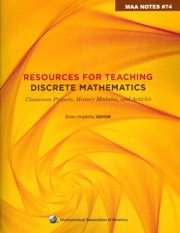Book contents
- Frontmatter
- Introduction
- Dedication
- Contents
- I Classroom-tested Projects
- The Game of “Take Away”
- Pile Splitting Problem: Introducing Strong Induction
- Generalizing Pascal: The Euler Triangles
- Coloring and Counting Rectangles on the Board
- Fun and Games with Squares and Planes
- Exploring Recursion with the Josephus Problem: (Or how to play “One Potato, Two Potato” for keeps)
- Using Trains to Model Recurrence Relations
- Codon Classes
- How to change coins, M&M's, or chicken nuggets: The linear Diophantine problem of Frobenius
- Calculator Activities for a Discrete Mathematics Course
- Bulgarian solitaire
- Can you make the geodesic dome?
- Exploring Polyhedra and Discovering Euler's Formula
- Further Explorations with the Towers of Hanoi
- The Two Color Theorem
- Counting Perfect Matchings and Benzenoids
- Exploring Data Compression via Binary Trees
- A Problem in Typography
- Graph Complexity
- II Historical Projects in Discrete Mathematics and Computer Science
- III Articles Extending Discrete Mathematics Content
- IV Articles on Discrete Mathematics Pedagogy
- About the Editor
Can you make the geodesic dome?
from I - Classroom-tested Projects
- Frontmatter
- Introduction
- Dedication
- Contents
- I Classroom-tested Projects
- The Game of “Take Away”
- Pile Splitting Problem: Introducing Strong Induction
- Generalizing Pascal: The Euler Triangles
- Coloring and Counting Rectangles on the Board
- Fun and Games with Squares and Planes
- Exploring Recursion with the Josephus Problem: (Or how to play “One Potato, Two Potato” for keeps)
- Using Trains to Model Recurrence Relations
- Codon Classes
- How to change coins, M&M's, or chicken nuggets: The linear Diophantine problem of Frobenius
- Calculator Activities for a Discrete Mathematics Course
- Bulgarian solitaire
- Can you make the geodesic dome?
- Exploring Polyhedra and Discovering Euler's Formula
- Further Explorations with the Towers of Hanoi
- The Two Color Theorem
- Counting Perfect Matchings and Benzenoids
- Exploring Data Compression via Binary Trees
- A Problem in Typography
- Graph Complexity
- II Historical Projects in Discrete Mathematics and Computer Science
- III Articles Extending Discrete Mathematics Content
- IV Articles on Discrete Mathematics Pedagogy
- About the Editor
Summary
Summary
This project uses the geodesic dome made famous by Buckminster Fuller to extend students' understanding of Eulerian graphs. Students are directed to build a dome and, after determining that the graphical representation of the dome contains neither an Euler cycle nor trail, to find the minimal number of repeated edges that are necessary to visit each edge.
Notes for the instructor
I have done this construction six times with classes of up to 30 students, and each time the entire activity took less than two 50-minute class periods. There are many jobs to be done: corners to be held, rope to be strung through pipe, pipes to be labeled, desks to be moved, and supervisory work. All of these jobs can be assigned to students.
The 0.884 ratio cited for edge lengths comes from [1] which cites spherical trigonometry for the derivation. The decimal approximation is precise enough for this construction.
Use rope that is at least as strong as clothesline, and pull it taut as you proceed. Start from the bottom (the outer ring) and work up; it also helps to duct tape the bottom to the floor. The construction will be flimsy until the final pipe is tied into place. Preparing the materials will take some effort, but students are very engaged by the activity.
Bibliography
[1] Lloyd Kahn, Domebook One, Pacific Domes, 1970.
[2] Hugh Kenner, Geodesic Math and How to Use It, University of California Press, 2003.
- Type
- Chapter
- Information
- Resources for Teaching Discrete MathematicsClassroom Projects, History Modules, and Articles, pp. 93 - 96Publisher: Mathematical Association of AmericaPrint publication year: 2009

